There probably aren’t that many people prepared to spend their Christmas holidays weaving nets in their own living rooms, but for David MacGillivray, Marine Harvest’s seawater manager, the determination to get to grips with gill health issues more than justified the strange looks he got from his children.
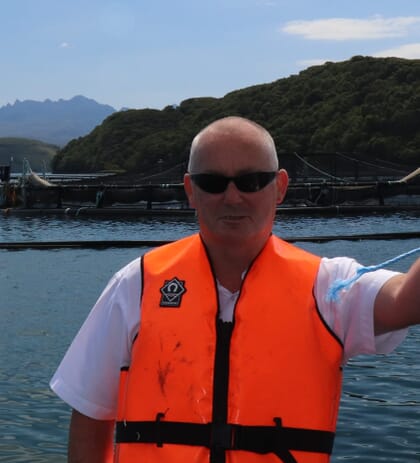
And, following nearly two years of trials and tribulations, his apparent bout of insanity is finally beginning to pay off – with fully functioning versions of the net now installed at three fish farms in Scotland, and gill health at these sites showing a marked improvement. Given the system’s huge global potential, it’s little wonder that he won the innovation category in this year’s Scottish Marine Aquaculture Awards.
Motivation
Gill-health issues have been a scourge of the global salmon-farming industry over recent years, often cited right up there with sea lice as the field’s single biggest health challenge. And it was the increasing prevalence of this issue that inspired David – who has been in the salmon-farming sector since 1989 – to act.
The reasons behind the increase in gill-health issues are undoubtedly numerous, with spikes in seawater temperatures often blamed for a decrease in water quality, but David suspects that there’s also a link to the use of hydraulic net cleaners.
“We knew that when we started in situ net cleaning that our gill health started to deteriorate,” David reflects. “It’s not just cleaning the net – putting high pressure in the water is affecting other things too. Whether it’s Japanese skeleton shrimp in the nets, jellyfish on the side of the nets, or jellyfish in the pen itself, they’re all getting obliterated and turned into small pieces that can get into the gills.”
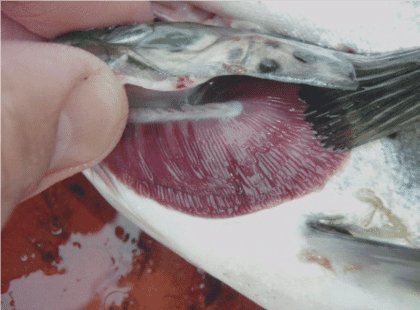
© Hamish Roger, Fish Vet Group
However, he admits, there may be a large number of different factors at work.
“We can’t put all the blame onto net cleaning because it’s a hard thing to monitor,” he adds. “New things [such as rising sea temperatures] are popping up all the time – we actually don’t know why some sites are worse than others for gill health, and it could be the things that we’re not seeing that are doing the damage. You can clean nets for three months and it won’t be an issue, then suddenly the gills start deteriorating.”
Whatever the cause, it was gill issues that had led to Marine Harvest mothballing Portnalong – a 2,500-tonne site off the Isle of Skye – for three years, but David felt that there was potential to reopen the site if different farming methods were used.
“We were putting a plan in place to farm Portnalong and decided to eliminate in situ net cleaning and come up with an alternative,” he explains.
“The options we had at the time were net changing with no antifoul or net changing with antifoul, which was the preferred option but not part of our long-term plan. It’s not a solution we like, partly because antifoul is unreliable in our experience, even though it is improving all the time,” he adds.
His mind therefore turned to Environets – a double net system produced by Mørenot in which the two nets can be rotated without removing the fish from the cage. This allows half of the net to be hung up and air-dried on the side of the pen in order to remove all the organic matter that accumulates on it, while the other is “swum” and contains the fish. Although widely used on steel cages, no one had managed to adapt the system for use on circular plastic pens.
“The bottom line was I thought that I’d like to try adapting an Environet. We use them on all our steel pens and I couldn’t figure out why we couldn’t make them work on the circles,” explains David.
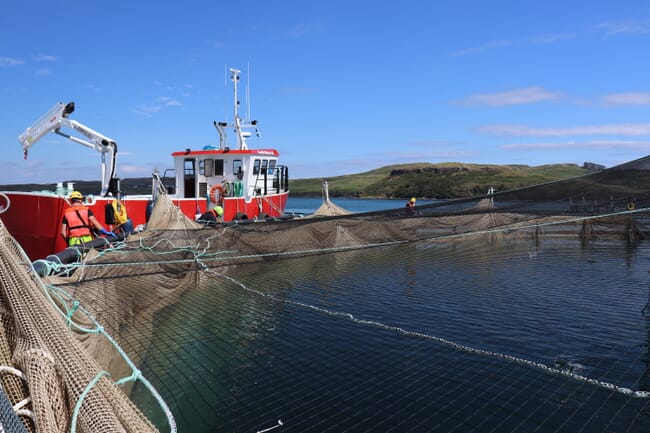
David’s determination shone through as he decided to tackle the issue head-on.
“During the Christmas holidays I got some net thread and a needle off a manufacturer and started making up a model net in my living room – my kids thought I was going off my head,” he recalls.
“But I made a net and AKVA built me a model cage for it and Ian Fraser [site manager at Laga Bay] came in one day and we did a virtual swim of the net in the office, to prove to ourselves that the concept could work. With a few modifications it clearly could.”
“I then invited David Goodlad over from Net Service Shetland [part of Mørenot] and explained to him what I wanted, scaling it up so it could be used in 120m cages which we could then trial at Lochalsh. He went away and built another model with better nets, re-proving what I’d done in the office and enabling him to show his guys what we were trying to achieve,” says David.
He was also in the relatively unique position of having not one, but two site managers called Ian Fraser to call on for support.
“We went down to Lochalsh with Faggie [Ian Fraser, site manager at Sconser] and his guys and the other Ian Fraser, sewed the two nets together and swum them on the same day,” says David.
Although this early trial showed that the nets could, in theory, work on circular cages, there were still a few obstacles to overcome – not least the need to establish a bracket that could hold the drying portion of the net without warping the circular pens.
“We upgraded our brackets and swam the net every 14 days. Everything was going fine. And then we put fish in it,” David explains, “which is where it started to go wrong…
“The farmers treated it like a normal pen, which was putting so much weight on the collar that the brackets couldn’t handle it and the cage become so distorted we had to take the fish out.”
David, who admits to a having a stubborn streak, was forced to go back to the drawing board.
“It would have been easy to walk away at that point, but we knew the principle was good. We discussed and discussed and ended up trialling five different bracket prototypes, which we designed with the help of an engineer from AKVA, Terry Nolan.
“The first four involved putting weight against the upright. They all made a difference but weren’t doing what we wanted in terms of the balance of the cage. So we thought about building a special Environet cage, but then Terry came up with a new suggestion for a design using a clamp round the bracket to take the weight off the handrail. We all knew that that was the right solution and we got a prototype and put it on – it was like night and day, and we haven’t changed them since. We’re now 100 percent sure that there is no issue with the cages,” David explains.
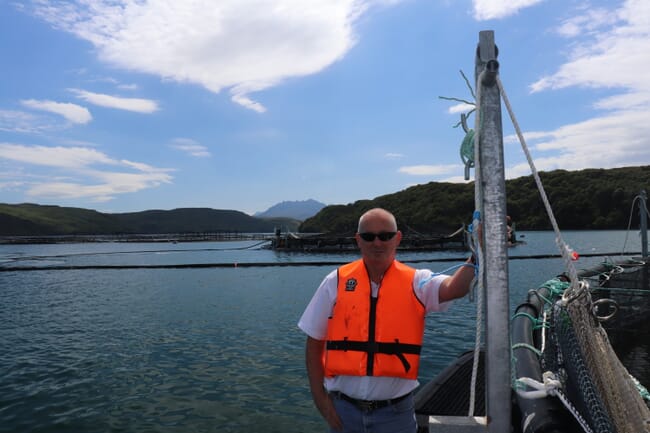
There was one last modification that needed to be made.
“After installing the first net I was driving down Lochalsh one night and I could see the drying portion of the net glowing from the shore. I know visual impact is a big thing, and I actually got our environmental-health team to call up the planners and tell them it was only temporary,” says David.
“So we decided to dip the top three metres in black dye and, because this is the last bit of the net to be hung out to dry, it acts as camouflage – the net just disappeared; it worked a treat. The dye also acts as a sealant, so helped to keep the top three metres that bit cleaner as well.”
And, since then, the nets and brackets have shown their worth.
“We’ve now put them on the three sites that have probably caused us the most issues with gill health over the years. Ornish, on South Uist, has had them since July 2017 and has got a chequered past with gill health; Portnalong has had them since February; and we’re going to do Greshornish next year.
There are also a number of other sites that David has earmarked for the new nets.
“Kingairloch is getting them as we speak, and there are plans to install them at Port na Crow and Pol na Ghillie (PNG) shortly too,” he says. “PNG’s not too bad in terms of gill health, but we believe it will make a difference. At Kingairloch it’s more of a cost issue. It’s a small site, just eight pens, and it’s isolated so it makes perfect sense not to have to use a net cleaner.”
And the performance of the sites with the new nets means that Environets are likely to be phased in more widely across the company’s marine sites.
“Ben [Hadfield, managing director of Marine Harvest Scotland] is keen to put more out but it’s a slow progression – you’ve got nets and systems in place already and if you installed Environets across the board you’d have to get rid of all that equipment. So we’re going to adopt a phased approach – as each site ends its cycle with conventional nets we’ll be considering replacing them with the new ones,” says David.
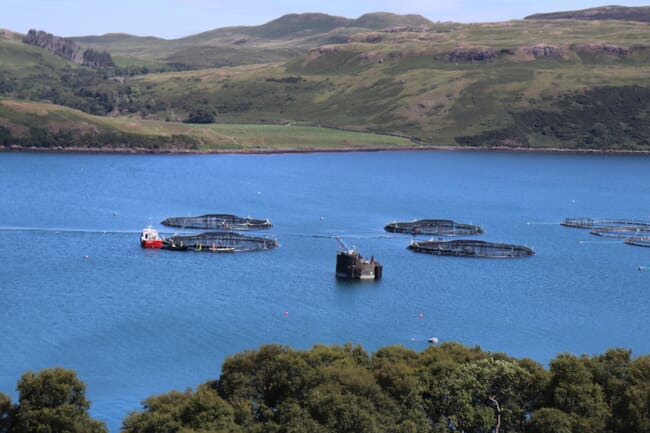
Those farm managers who’ve had the chance to operate the new net system are also backing the idea.
“I think they’re very easy to use,” reflects Ian 'Faggy' Fraser. “I actually prefer using them on the circles than the steels – I think they’re easier. It’s also less hassle – no net washing’s good for us. It makes a difference.”
“I’m absolutely delighted,” adds Hugh MacKinnon, area manager for Marine Harvest north. “I’d be pleased to use the new nets at every site that could handle them – Portnalong’s got the cleanest nets of any of the circle pens [in my area].”
Sites with the new nets may need to be run slightly differently – and have the nets changed every two weeks – but the results suggest that the change is eminently worthwhile, as a visit to Portnalong confirms.
Managerial approval
Portnalong’s manager, Kurk Jones, is certainly getting to grips with the Environets and is a firm believer in their advantages.
“The site has never been bad for lice, but it’s always had problems with water quality – it’s essentially a loch, within a loch, within a loch. But since we put in the Environets we’ve not needed to do any gill treatments and if we can get through the summer without doing one we’ll delighted,” he explains.
Portnalong may be Kurk’s first managerial posting, but the 24-year-old was recently singled out by Marine Harvest as one of the salmon sector’s brightest prospects – nominating him for the Rising Star category at the Scottish Marine Aquaculture Awards, where he made the shortlist.
Certainly his work at Portnalong, where he’s been tackling a new net system with a team largely made up of new recruits, has been impressive. Despite the team’s relative lack of experience, the logistics of using and changing the nets have gone remarkably smoothly.
“Of the seven people on site four of them are brand new to fish farming,” Kurk explains, “but [we’ve got to grips with the techniques and] it now takes five of us only two hours to change the net,” he reflects.
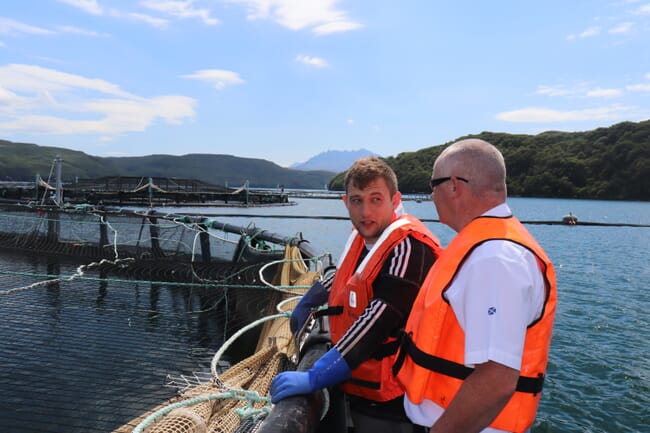
How it works
The double net system is so effective because the drying process kills off all the organisms that have grown on the mesh.
“When you clean a net it’s like cutting the grass – you just trim it – but the net’s still seeded and as soon as you stop cleaning it starts growing again,” David explains. “With an Environet, as each net spends two weeks out of the water, everything on it is killed, so it [the fouling] needs to reseed from scratch when you put the net back in the water.”
“You’re effectively putting a new net on every 14 days. It’s the golden rule – never break it. Once you get a bit of growth there’s potential for it to survive the two weeks out of the water,” David stresses.
“It’s more labour intensive – as a rough rule of thumb we anticipate that we’re using one extra person per site, but we did a cost analysis and using Environets appears to come out level with net cleaning,” adds David.
Clear benefits
The system it also, of course, creates a number of benefits.
“From my perspective the three benefits are: fish performance – better gill health and improved oxygen flow; the benefits to the cleanerfish performance – it makes them more effective at eating lice if they don’t have another food source on the side of the cage; and there’s the environmental performance – you’re not knocking fouling to the seafloor and you’re not copper treating or using antifoulant,” says Ian Roberts, the company’s new director of communications.
“Another benefit is that you’re seeing your whole net with your own eyes every two weeks so can see if there’s any damage to it. It’s quite easy to spot even a single mesh break or any net fatigue when you’re changing the nets,” adds David.
As well as helping to reduce the chance of escapes, the system also minimises stress for the fish – which is in itself a major health benefit.
“It’s much less stressful than net cleaning or changing the net [as traditional net changes require the fish to be transferred to a wellboat],” David reflects.
Patent pending
The new design has, understandably, attracted plenty of attention and Marine Harvest are looking to secure a patent on the system.
“It’s patent pending at the moment,” says David. “The patent involves the whole process, including both the bracket and the net.”
It’s also caught the eye of Marine Harvest’s Norwegian HQ.
“They’re coming over in August to look at it and try and adapt it to their pens – in Norway they’ve got bigger cages, up to 200m, but in my opinion the system can be scaled up, it’s just a question of using more brackets and redesigning the net accordingly. There will be a formula that we discover about the maximum distance between the lifting brackets,” says David.
Once patented and an agreement with a commercial partner has been reached Marine Harvest would like to see the system used more widely, and not just by their own affiliates.
“A couple of the smaller producers in Scotland have expressed an interest, but they’ve not actioned anything yet,” David reflects.
However, if the results of the new Environets remain positive it seems eminently possible that salmon farmers not just from from Unst to Arran, but also from Ushuaia to the Arctic Circle, may be operating the double net system before long.



